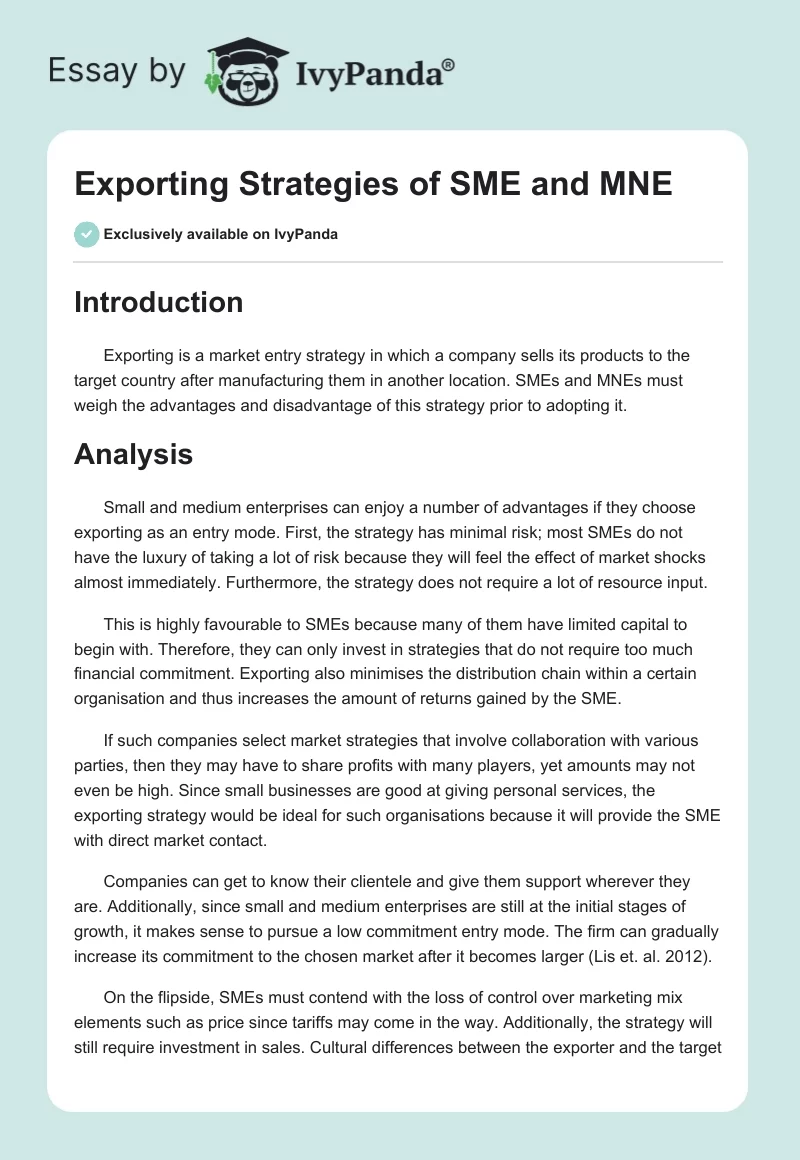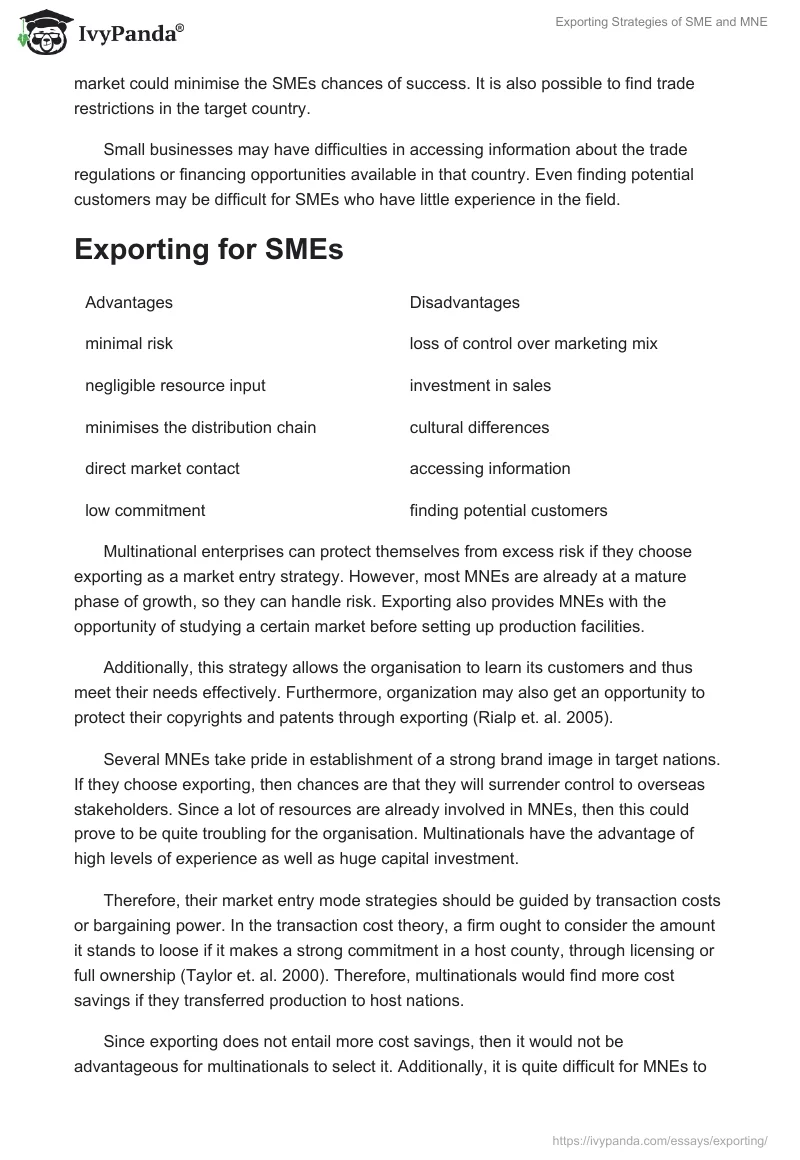Introduction
Exporting is a market entry strategy in which a company sells its products to the target country after manufacturing them in another location. SMEs and MNEs must weigh the advantages and disadvantage of this strategy prior to adopting it.
Analysis
Small and medium enterprises can enjoy a number of advantages if they choose exporting as an entry mode. First, the strategy has minimal risk; most SMEs do not have the luxury of taking a lot of risk because they will feel the effect of market shocks almost immediately. Furthermore, the strategy does not require a lot of resource input.
This is highly favourable to SMEs because many of them have limited capital to begin with. Therefore, they can only invest in strategies that do not require too much financial commitment. Exporting also minimises the distribution chain within a certain organisation and thus increases the amount of returns gained by the SME.
If such companies select market strategies that involve collaboration with various parties, then they may have to share profits with many players, yet amounts may not even be high. Since small businesses are good at giving personal services, the exporting strategy would be ideal for such organisations because it will provide the SME with direct market contact.
Companies can get to know their clientele and give them support wherever they are. Additionally, since small and medium enterprises are still at the initial stages of growth, it makes sense to pursue a low commitment entry mode. The firm can gradually increase its commitment to the chosen market after it becomes larger (Lis et. al. 2012).
On the flipside, SMEs must contend with the loss of control over marketing mix elements such as price since tariffs may come in the way. Additionally, the strategy will still require investment in sales. Cultural differences between the exporter and the target market could minimise the SMEs chances of success. It is also possible to find trade restrictions in the target country.
Small businesses may have difficulties in accessing information about the trade regulations or financing opportunities available in that country. Even finding potential customers may be difficult for SMEs who have little experience in the field.
Exporting for SMEs
Multinational enterprises can protect themselves from excess risk if they choose exporting as a market entry strategy. However, most MNEs are already at a mature phase of growth, so they can handle risk. Exporting also provides MNEs with the opportunity of studying a certain market before setting up production facilities.
Additionally, this strategy allows the organisation to learn its customers and thus meet their needs effectively. Furthermore, organization may also get an opportunity to protect their copyrights and patents through exporting (Rialp et. al. 2005).
Several MNEs take pride in establishment of a strong brand image in target nations. If they choose exporting, then chances are that they will surrender control to overseas stakeholders. Since a lot of resources are already involved in MNEs, then this could prove to be quite troubling for the organisation. Multinationals have the advantage of high levels of experience as well as huge capital investment.
Therefore, their market entry mode strategies should be guided by transaction costs or bargaining power. In the transaction cost theory, a firm ought to consider the amount it stands to loose if it makes a strong commitment in a host county, through licensing or full ownership (Taylor et. al. 2000). Therefore, multinationals would find more cost savings if they transferred production to host nations.
Since exporting does not entail more cost savings, then it would not be advantageous for multinationals to select it. Additionally, it is quite difficult for MNEs to respond to customer demands as effectively as smaller organisation. Products that require onsite support cannot be sold effectively (Whelan et. al. 2011).
Exporting for MNEs
Having considered the advantages and disadvantages of exporting as a market entry strategy, it is clear that companies must strike a balance between risk aversion and customer contact. SMEs have minimal resources so they are bound to be more risk averse than MNEs; exporting is thus ideal for them.
Besides, SMEs are still at the early stages of business growth, so they need to learn new markets before they can increase their commitment. On the other hand, MNEs have already reached a maturity phase, their concern should be cost savings in production rather than risk aversion, so exporting would not make much sense.
Small and medium sized enterprises are in a position to offer highly personalised service; conversely, MNEs may not prioritise this issue as much as smaller firm, so exporting would be more suitable for SMEs. Nonetheless, both organisations may need to exert control over their businesses if they sell technical items or if they value their brand image.
Furthermore, an MNE may have experienced a series of internationalisation failures in various markets; therefore, it may be more risk averse than usual (Ahsan & Musteen, 2011). The dependence of most exporting businesses on people power may cause SMEs and MNEs to consider the strategy. Customer support is still a valued trait regardless of whether an enterprise is small or large.
Conclusion
The low level of commitment associated with exporting strategies is highly appropriate for SMEs as they have few resources and are still growing. SMEs do not have the luxury of risk-taking, and they value the personalisation of services; these are all qualities that are synonymous with exporting.
Conversely, MNEs can afford risk and if they choose exporting, they would loose the benefit of transferring production to an economical location. Furthermore, some of the benefits of exporting, like personalisation of services, are not valuable to MNEs. These factors make exporting more appropriate for SMEs than MNEs
References
Ahsan, M & Musteen, M 2011, ‘Multinational enterprises’ entry mode strategies and uncertainty: A review and extension’, International Journal of Management Reviews, vol. 13 no. 4, pp. 376-392.
Lis, B, Nienstedt, H, Proner, P, Yalazo, G & Mauch, A 2012, ‘SMEs going global: A comparison of internationalisation strategies of publishers and online social networks’, International Review of Management and Marketing, vol. 2 no. 1, pp. 1-9.
Rialp, A, Rialp, J & Knight, M 2005, ‘The phenomenon of international new ventures, global start ups and born-globals: what do we know after a decade (1993-2002) of exhaustive scientific inquiry?’, International Business Review, vol. 14, pp. 147-166.
Taylor, C, Osland, G & Zou, S 2000, ‘Foreign market entry strategies of Japanese MNCs’, International Marketing Review, vol. 17 no. 2, pp. 146-156.
Whelan, J, Marshall, R & Ryan, G 2011, ‘Multinational companies account for bulk of irish exports’, IDA Ireland, 27 July, p. 15.


